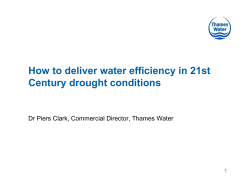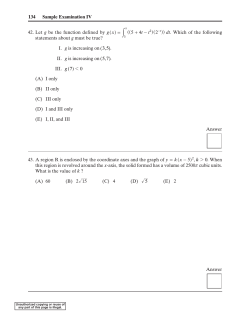
Results from the 2013 Global Ethnohydrology Study
Public Perceptions of Wastewater Treatment and Reuse in Phoenix, AZ: Results from the 2013 Global Ethnohydrology Study Rhian Stotts1, Margaret du Bray1, Jacelyn Rice2, Paul Westerhoff3, Amber Wutich1, and Alexandra Brewis1 1School of Human Evolution and Social Change, Arizona State University, 2Center for Environmental Implications of Nanotechnology, Duke University, 3School of Sustainable Engineering and The Built Environment , Arizona State University Data Analysis The Global Ethnohydrology Study is a transdisciplinary, multi-year, multi-site research project designed to survey crosscultural understandings of water issues. The 2013 iteration focused on local knowledge of wastewater treatment and perceptions of its potential reuse. Public Perception and Acceptance It is widely recognized that public perception and acceptance of wastewater reuse are the primary hindrances to successful implementation of reuse projects. While water utilities have undertaken large marketing campaigns to influence people to use reclaimed water, these have been shown to be unsuccessful and we still know little about the public’s awareness of de facto reuse, particularly regarding how awareness impacts public perceptions of water reuse. Results • Filtration is the most commonly depicted treatment process. • Advanced treatments that can remove the impurities from wastewater such that it is almost of drinking water quality (i.e. UV treatment, ozonation, and nitrogen and phosphorus removal) were rarely, if ever, depicted. • 37% of respondents indicated that their communities have had conversations about wastewater treatment and reuse but this was not a factor in what treatment type was depicted by the respondents. Examples Figure 1. Coded Present for Non-‐Linear/Cyclical, Residen@al Source, Centralized System, Filtra@on, Sedimenta@on, UV Treatment, Dis@lla@on, Indirect and Potable Reuse 30 Figure 3. Coded Present for Linear, General Wastewater Source, Centralized System, Chemical Disinfec@on, Chemical Addi@ve, Filtra@on, Direct and Potable Reuse Figure 2. Coded Present for Non-‐Linear/Cyclical, Residen@al Source, Centralized System, Filtra@on, Chemical Addi@ve, Aera@on, Direct and Potable Reuse Number of Occurences Introduction Using a visual content analysis approach, we created codes to classify drawings and accompanying statements as follows. • Treatment Scale (water treatment only, wastewater treatment only, combined water and wastewater treatment, uncodeable treatment, and no treatment) • Wastewater source (residential, industrial, and general wastewater) • Process (linear, linear but also cyclical, non-linear/cyclical, and single step) • System (centralized and decentralized) • Treatment Types (testing, chemical disinfection, chemical additive, filtration, purification, sterilization, sedimentation, UV treatment, ozonation, reverse osmosis, desalinization, distillation, boiling, aeration • Reuse (direct reuse, indirect reuse, potable reuse, non-potable reuse) • Buffers (environmental buffer, mixed water) 25 20 15 10 5 0 Treatments Figure 7. Bar Chart Showing the Number of Occurrences of Treatment Types Figure 4. Coded Present for Linear but also cyclical, Residen@al Source, Centralized System, Tes@ng, Chemical Disinfec@on, Filtra@on, Direct and Potable Reuse Data Collection • A purposive sampling strategy was used to capture local Phoenix residents’ perceptions of wastewater treatment and reuse as well as respondent demographics. A total of 59 respondents participated. • 53 respondents drew an image in response to the question “Imagine that wastewater will be processed and then delivered again to people’s tap for drinking. Please draw or depict the treatment path that you think wastewater should take so that it can become drinkable again. • 38 respondents drew wastewater or combined water and wastewater treatment. Actual and Ideal Wastewater Treatment Diagrams Figure 5. Payson Wastewater Treatment (hRp:// www.waterenergy.nau.edu/ payson.html) Figure 6. Generalized Flow Diagram for Municipal Wastewater Treatment (Asano et al. 1985) Wastewater Reuse in Phoenix Previous research by several of the co-authors found that in Phoenix, under average streamflow conditions, de facto wastewater reuse occurs in up to 3% of the Phoenix water supply. This rate was lower than what was perceived by the majority (71%) of respondents to be an acceptable percentage. Additionally, 24% of respondents thought that treated wastewater was already present in their tap water. Future Research • In addition to the drawings, level of disgust (the “yuck” factor) was assessed through several scalar questions that have yet to be analyzed. • Comparable data was also elicited in eight other countries (Australia, China, Fiji, Guatemala, New Zealand, Spain, Switzerland, and the United Kingdom) and cross-country analysis is forthcoming. Acknowledgements: The Global Ethnohydrology Study was conducted with funding from National Science Foundation award SES-0951366 (Decision Center for a Desert City II: Urban Climate Adaptation), National Science Foundation awards BCS-1026865 and DEB-0423704 (Central-Arizona Phoenix Long-term Ecological Research), and the Arizona State University Late Lessons from Early History initiative.
© Copyright 2025











